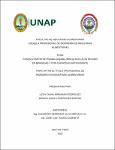Pasas a partir de Physalis angulata (bolsa mullaca) secado en bandejas y con capacidad antioxidante

View/
Date
2022Author
Arriaran Rodriguez, Leidy Diana
Rodríguez Bartra, Mónica Sheila
Metadata
Show full item recordAbstract
In the Peruvian Amazon there is a wide variety of fruit tres whose fruit production has not been exploited technologically, such as Physalis angulata (Bolsa mullaca), for this reason this research was to obtain a technology for the production of Physalis angulata raisins using the drying technique in trays with a high antioxidant capacity, the desing was experimental, completely experimental and randomized, with two study factors and three levels respectively; The best producto determined by the different analyzes were the raisins dried at 55°C for 27.5 hours with physicochemical values of 14.34% moisture, 4.37% ash, 1.43% fat, 5.92% protein, 73.94% carbohydrate, 16.77% total fiber, 2.24% acidity, 5.20 pH and suitable for human consumption determined by microbiological análisis and has a shelf life of approximately one year; on the other hand, the antioxidant activity determinated by the DPPH method presented a value of 4,199± 1,844 umolTE/g dry matter, ABTS of 35,039±1,926 umolTE/g dry matter and total phenols of 1,716 (±0,266) mgGAE/g. The technology found can contribute to the development of the región and especially to the producers of this fruit. En la Amazonía peruana existe una gran variedad de árboles frutales cuya producción de frutos no han sido aprovechada de forma tecnológica, como la Physalis angulata (Bolsa mullaca), por eso esta investigación fue para obtener una tecnología para la elaboración de pasas de Physalis angulata (Bolsa mullaca) mediante la técnica de secado en bandejas con una alta capacidad antioxidante, el diseño fue de tipo experimental, completamente experimental y aleatorizado, con dos factores de estudio y tres niveles respectivamente; El mejor producto determinado por los diferentes análisis fueron las pasas secadas a 55°C por 27.5 horas, con valores fisicoquímicos de 14.34% de humedad, 4.37% de cenizas, 1.43% de grasas, 5.92% de proteínas, 73.94% de carbohidratos, 16.77% de fibra total, 2.24% de acidez, 5.20 de pH y aptos para consumo humano determinado por el análisis microbiológico y tiene una estabilidad de vida de aproximadamente un año; por otro lado, la actividad antioxidante determinada por el método DPPH presentó un valor de 4.199 ±1.844 umolTE/g materia seca, ABTS de 35.039 ±1.926 umolTE/g materia seca y fenoles totales de 1.716 (±0.266) mgGAE/g. La tecnología encontrada puede contribuir al desarrollo de la región y especialmente a los productores de este fruto.
Collections
- Tesis [122]

